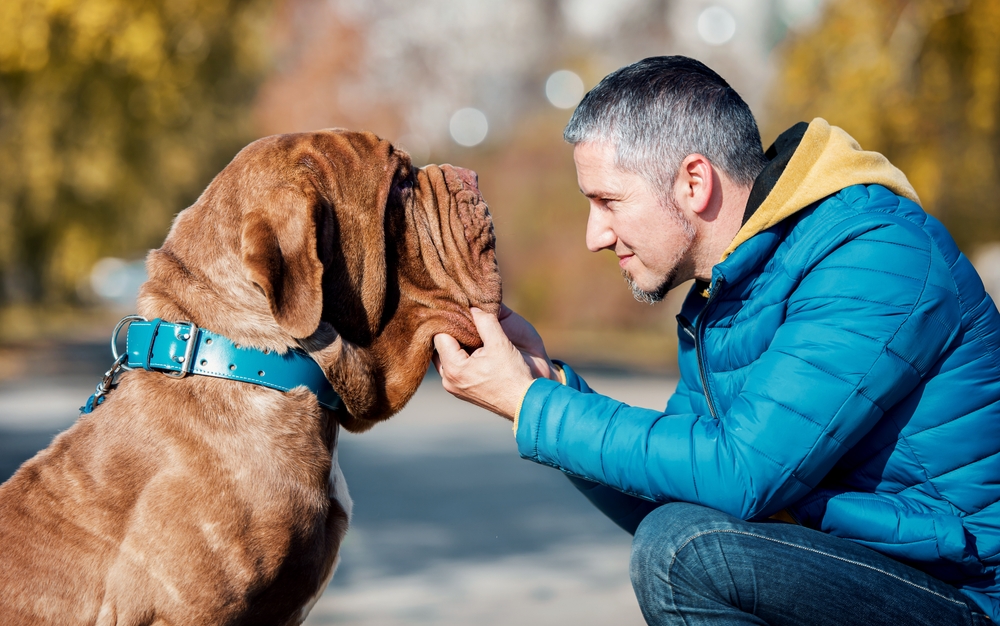Dogs don’t just pick up on basic commands; they understand much more about human communication than we often give them credit for. From tone to context, your fur baby is quietly soaking in information and forming a thoughtful, non-verbal response. Here are 13 things your dog knows about your words, even if you don’t realize it.
1. They Understand Your Tone

Your dog doesn’t just listen to what you say; they tune into how you say it. The tone of your voice can convey joy, anger, and urgency, giving your dog clues about your emotional state and what might be coming next. According to a study published in the journal Science, dogs use the same part of their brains as humans to process vocal tones. They instinctively react to these tonal cues, which is why your dog can sense when you’re upset, even if you’re trying to mask it.
Beyond tone, the rhythm and pitch of your voice also play a role. Dogs are adept at detecting pitch changes that might indicate excitement or tension. They’ve learned that a high-pitched, cheerful tone often means something positive, like playtime or treats. Conversely, a low, stern voice might mean they’re in trouble, prompting your pup to adjust their behavior accordingly.
2. They Know Specific Words

You might be surprised to know that your dog can recognize more words than just “sit” or “stay.” Over time, they learn to associate specific words with actions, objects, or people. While they don’t understand language in the same way humans do, they excel at linking words with outcomes. When you say “walk,” your dog might dash to the door, already excited about the outing.
This word recognition is a result of repetition and context. Dogs are observant and will quickly connect the dots between your words and the actions that follow. So, if you frequently use the word “car” before a drive, don’t be surprised if your dog starts getting excited whenever you mention it. Consistent associations help them expand their vocabulary over time.
3. They Read Contextual Cues

Dogs are experts at reading situations, often using context to fill in the gaps of what they don’t understand. Research by canine cognition expert Dr. Alexandra Horowitz indicates that dogs are remarkably adept at using environmental cues to interpret human words and actions. For instance, if you pick up a leash, your dog might infer that it’s time for a walk, even if you haven’t said a word. They piece together these contextual clues to anticipate your next move.
Contextual understanding is crucial for dogs because it helps them navigate a world dominated by human language. They watch your body language, listen to your tone of voice, and observe the setting to derive meaning. This skill is why your dog might react differently to the same command given in different contexts. It’s all about the bigger picture for them — connecting the dots between what they hear and what they see.
4. They Pick Up On Any Changes

Dogs are creatures of habit, and they pick up on patterns in your daily routine. If something changes, even slightly, they notice and respond accordingly. Whether it’s a shift in your morning routine or a change in the time you usually come home, your dog is likely to pick up on it. This sensitivity to routine extends to your verbal habits, too.
When you deviate from your usual phrases or commands, your dog may become confused or anxious. They rely on consistency in your words to help them predict what happens next. This is why training commands need to be clear and consistent; mixed signals can lead to misunderstandings. For dogs, routine and repetition are key to understanding and comfort.
5. They Sense Emotional Shifts

Your dog is incredibly attuned to emotional changes, often before you even say a word. According to a study from the University of Lincoln, dogs can read human emotions through facial expressions and vocal tones. This ability allows them to sense when you’re happy, sad, stressed, or calm, responding with comforting nuzzles or playful antics. They don’t need you to articulate your feelings; they’re already instinctively aware of them.
This perception extends to the way they interpret your words and actions. If you speak in a tense or hurried manner, your dog might sense your anxiety and react accordingly. Conversely, a gentle and relaxed tone can soothe them, even during stressful situations like vet visits. Your emotional state, as conveyed through your voice, impacts how they respond to your words.
6. They Can Interpret Commands vs. Conversation

Dogs are skilled at distinguishing between words meant for them and casual conversation. They pick up on verbal cues that indicate a command, like the sharpness or emphasis of your voice. When you’re talking to another person, your dog will often tune out, knowing those words aren’t directed at them. However, the moment you switch your attention and tone toward them, they’re back in listening mode.
This ability to differentiate comes from your dog’s interaction with you over time. They learn which words and tones are important to their behavior and which aren’t. Commands are often followed by direct actions or rewards, making them more meaningful to your dog. So while they might ignore your phone conversations, they’re immediately alerted when you call their name.
7. They Love Repetition

Repetition is a powerful tool in helping dogs understand and respond to words. Consistently using the same words for specific actions or objects helps solidify their meaning in your dog’s mind. A study from the Journal of Comparative Psychology reveals that repetition strengthens the neural pathways in dogs’ brains, enhancing their ability to learn and recognize words. It’s how they come to understand that “sit” means lowering their haunches and “treat” means delicious rewards.
Just as humans learn through repetition, dogs do too. They thrive on consistency, and repeated exposure helps them form associations between words and actions. This is why training sessions often involve repeating the same command multiple times. Over time, this repetition helps your dog become more confident and responsive to your verbal cues.
8. They Watch Body Language Too

While words are important, your body language speaks volumes to your dog. They’re masters at interpreting gestures, eye movements, and postures to understand what you might be saying. Even if your words are unclear, your dog can often guess your intentions by watching your physical cues. This skill is why your dog might respond to a hand signal just as well as a verbal command.
Body language is a significant part of canine communication, both with humans and other dogs. They pick up on the subtleties, like a pointed finger or a raised eyebrow, to guide their responses. Combining verbal commands with consistent hand signals can reinforce your dog’s understanding of your words. It’s a multi-sensory approach that helps bridge any gaps in communication.
9. They Comprehend Command Sequences

In addition to interpreting individual words, dogs can also understand sequences of commands. This skill is often seen in canine training where dogs are taught to follow a series of instructions in a specific order. They learn to anticipate the next command based on the sequence they’ve been trained to follow. This sequential understanding demonstrates their ability to process more complex linguistic structures.
Dogs rely on patterns and predictability to follow these sequences. Whether it’s “sit, stay, come” or a series of agility commands, they learn to anticipate the next step through repetition and reward. This ability to follow sequences makes them excellent working dogs in fields like search and rescue or service roles. It’s a testament to their cognitive abilities and their understanding of structured language.
10. They Associate Words with Actions

Dogs are quick to connect words with actions, often faster than we realize. When you say “walk” and then immediately grab the leash, your dog links the word with the action of going outside. This association is strengthened by repetition, making words like “car” or “dinner” trigger specific anticipatory behaviors. It’s this associative learning that forms the basis of effective communication between you and your dog.
Your dog’s ability to form these associations relies heavily on context and consistency. They watch for cues that link words with specific outcomes, which helps them predict what happens next. Over time, these word-action connections become almost instinctual, guiding your dog’s responses to your verbal cues. It’s a straightforward but powerful way that dogs navigate a world ruled by human language.
11. They Listen for Key Words

When you’re chatting away, your dog has an incredible knack for picking out key words that matter to them. While they might not understand full sentences, they’ll hone in on words like “park” or “treat.” These words have been repeatedly linked to positive experiences, making them stand out in the sea of human chatter. Your dog’s ears might perk up at these keywords, ready for action even if they’ve been dozing off.
This selective listening is a testament to your dog’s focus and adaptability. They learn to filter through the noise to find the words that hold meaning for them. It’s a skill that allows them to be part of your world, even if they don’t grasp every detail. By focusing on key words, your dog ensures they don’t miss out on the experiences they’ve come to love.
12. They Ignore Unimportant Words

Just as your dog listens for key words, they also learn to tune out the unimportant ones. In the same way humans mentally filter out background noise, dogs disregard words that don’t pertain to them. This filtering helps them focus on what truly matters, conserving their energy for more relevant interactions. They’ve mastered the art of selective hearing, ensuring they’re not overwhelmed by constant human chatter.
This skill is crucial for dogs living in busy households. They learn which words and phrases are worth responding to, creating mental shortcuts that streamline their communication. It’s why your dog might ignore your long-winded explanations but spring to attention at the mention of “outside.” By ignoring the unnecessary, dogs keep their attention finely tuned to the words that impact their world.
13. They Can Feel Your Intent

Beyond words and tones, dogs have an uncanny ability to sense your intentions. This perception goes beyond mere observation; it’s an intuitive understanding of your mood and expectations. Whether you’re gearing up for a playful session or preparing for a vet visit, your dog can often sense your intentions before you even speak. It’s this intuitive grasp that makes them such empathetic companions.
Your intentions are often conveyed through subtle cues, both verbal and non-verbal. Dogs pick up on these signals, adjusting their behavior to align with what they perceive you want. It’s a mutual understanding that forms the foundation of a strong human-dog bond. While words are important, it’s your underlying intent that truly guides your dog’s response.
